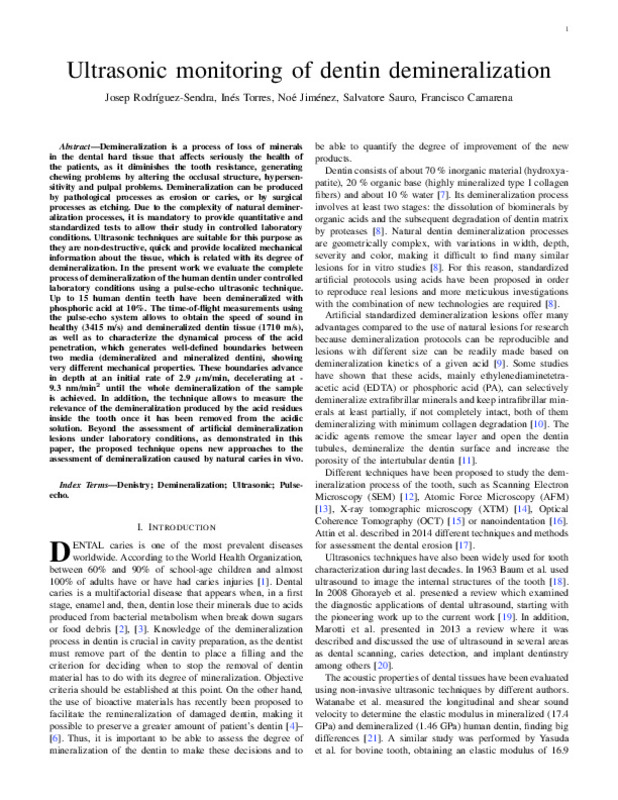|
Resumen:
|
[EN] Demineralization is a process of loss of minerals in the dental hard tissue that affects seriously the health of the patients, as it diminishes the tooth resistance, generating chewing problems by altering the occlusal ...[+]
[EN] Demineralization is a process of loss of minerals in the dental hard tissue that affects seriously the health of the patients, as it diminishes the tooth resistance, generating chewing problems by altering the occlusal structure, hypersensitivity, and pulpal problems. Demineralization can be produced by pathological processes as erosion or caries, or by surgical processes as etching. Due to the complexity of natural demineralization processes, it is mandatory to provide quantitative and standardized tests to allow their study in controlled laboratory conditions. Ultrasonic techniques are suitable for this purpose as they are nondestructive, quick, and provide localized mechanical information about the tissue, which is related with its degree of demineralization. In the present work, we evaluate the complete process of demineralization of the human dentin under controlled laboratory conditions using a pulse-echo ultrasonic technique. Up to 15 human dentin teeth have been demineralized with phosphoric acid at 10%. The time-of-flight measurements using the pulse-echo system allows to obtain the speed of sound in healthy (3415 m/s) and demineralized dentin tissue (1710 m/s), as well as to characterize the dynamical process of the acid penetration, which generates well-defined boundaries between two media (demineralized and mineralized dentin), showing very different mechanical properties. These boundaries advance in depth at an initial rate of $2.9~\mu \text{m}$ /min, decelerating at ¿9.3 nm/min 2 until the whole demineralization of the sample is achieved. In addition, the technique allows to measure the relevance of the demineralization produced by the acid residues inside the tooth once it has been removed from the acidic solution. Beyond the assessment of artificial demineralization lesions under laboratory conditions, as demonstrated in this article, the proposed technique opens new approaches to the assessment of demineralization caused by natural caries in vivo .
[-]
|
|
Agradecimientos:
|
This work was supported in part by the Spanish Ministry of Science, Innovation and Universities (MICINN) under Grant "Juan de la Cierva -Incorporacion" (IJC2018-037897-I) and Grant "Proyectos I + D + i 2019" (PID2019-111 ...[+]
This work was supported in part by the Spanish Ministry of Science, Innovation and Universities (MICINN) under Grant "Juan de la Cierva -Incorporacion" (IJC2018-037897-I) and Grant "Proyectos I + D + i 2019" (PID2019-111436RB-C22), in part by the Agencia Valenciana de la Innovacio under Grant INNCON/2020/009, and in part by the European Union through the Programa Operativo del Fondo Europeo de Desarrollo Regional (FEDER) of the Comunitat Valenciana 2014-2020 under Grant IDIFEDER/2018/022
[-]
|







![[Cerrado]](/themes/UPV/images/candado.png)


